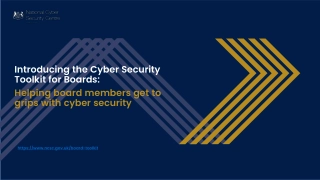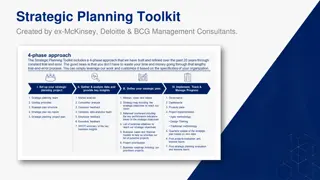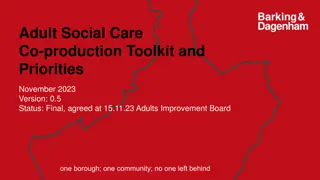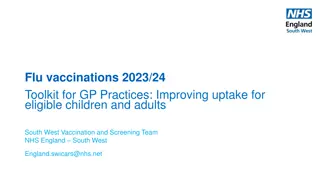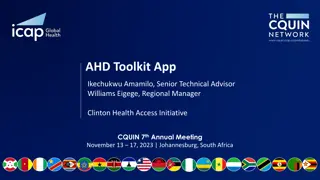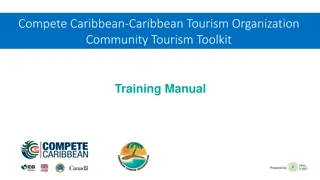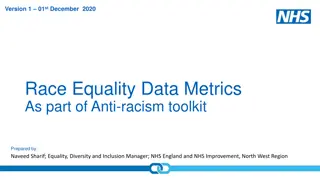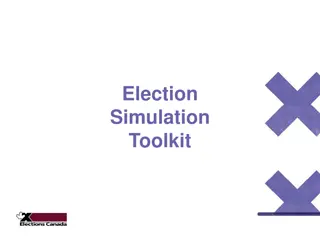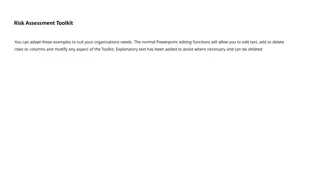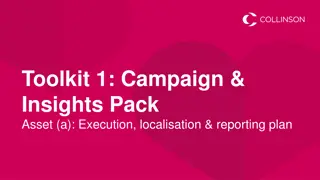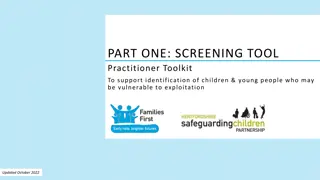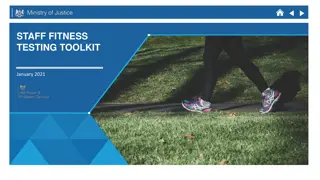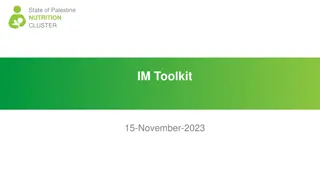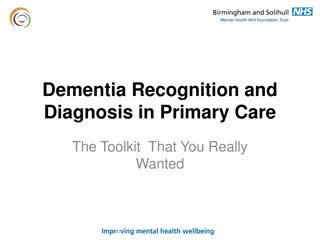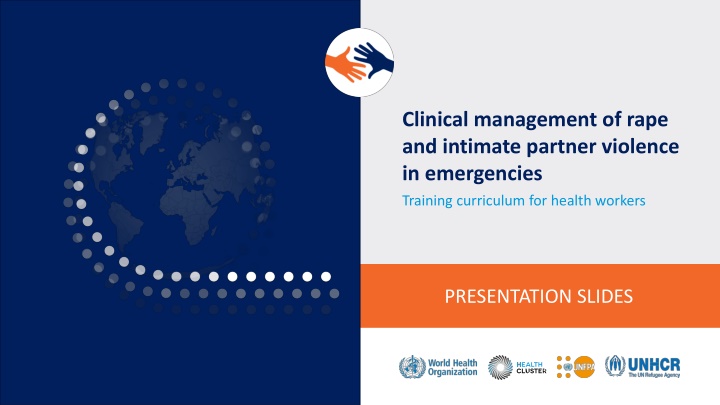
Clinical Management of Rape and Intimate Partner Violence Training Curriculum for Health Workers
Explore a comprehensive training curriculum designed to equip health workers with the necessary skills to provide first-line support for survivors of rape and intimate partner violence in emergency situations. Learn about essential practices like listening, inquiring, and validating to empower survivors and promote healing.
Download Presentation

Please find below an Image/Link to download the presentation.
The content on the website is provided AS IS for your information and personal use only. It may not be sold, licensed, or shared on other websites without obtaining consent from the author. If you encounter any issues during the download, it is possible that the publisher has removed the file from their server.
You are allowed to download the files provided on this website for personal or commercial use, subject to the condition that they are used lawfully. All files are the property of their respective owners.
The content on the website is provided AS IS for your information and personal use only. It may not be sold, licensed, or shared on other websites without obtaining consent from the author.
E N D
Presentation Transcript
Clinical management of rape and intimate partner violence in emergencies Training curriculum for health workers PRESENTATION SLIDES
Session 7. First-line support using LIV(ES), part 1: Listen, Inquire, Validate 7.2
Session objectives Objective 3: Demonstrate clinical skills appropriate to one s scope of practice to respond to sexual assault and IPV Competencies: Know the content of first-line support (LIVES) Demonstrate skills in offering the first three elements (listening, inquiring and validating) of first-line support to survivors who disclose abuse 7.3
First-line support Learn to listen with your: Eyes giving her your undivided attention Ears truly hearing her concerns and questions Heart hearing with caring and respect 7.4
First-line support for children and adolescents The 2 Cs, CC Child- and adolescent-friendly environment Caregiver support Provide age-appropriate information in an age and life-stage tailored manner and environment Involve a non-offending caregiver in all aspects of first-line support Empower non-offending caregivers with information about care, referral resources and ongoing support, and healing Respect the survivor s opinions, beliefs, thoughts and choices regardless of their age 7.5
Special considerations for inquiry Know and follow mandatory reporting laws and protocols regarding child abuse Know the national and local laws regarding consent for minors for medical care and treatment Be mindful that the adult who has brought the child to the health centre may be the perpetrator or complicit in the abuse 7.6
What is first-line support? DO Identify needs and concerns Respond to emotional, physical, safety and support needs Listen to and validate experiences and concerns Help her feel connected to others, calm and hopeful Empower her to feel able to help herself and to seek help Explore options Respect her wishes 7.7
Dos for LIVES + CC DO Speak in a way the child understands Help the child to feel safe Pay extra attention to non-verbal communication Reassure the child or adolescent that they are not at fault Make extra time to explain and help the child understand why you are talking about these things Refer to or bring in a child advocate or social worker if a non-offending family caregiver is unavailable 7.8
What is first-line support? DON T Don t: Try to solve her problems Try to convince her to leave a violent relationship Try to convince her to go to the police or courts Try to figure out why something happened 7.9
Donts for LIVES + CC DON T Assume a young person cannot be in an intimate relationship Force a child or adolescent to answer questions Expect children to be able to convey all information verbally Assume the adult accompanying the child is a non-offending caregiver 7.10
Listen DO Be patient and calm. Allow for silence. Look at her, nod your head, and make acknowledging sounds ( mmm ). Have open, relaxed expressions. Encourage her to keep talking. Ask: Would you like to tell me more? Invite disclosure. Ask: How can I help you? 7.11
Listen DON T Don t hurry or pressure her into telling her story. Don t look at your phone or watch. Don t answer the phone. Limit note- taking. Decline interruptions or other patients unless critical to save a life. Don t judge what she is telling you or try to figure out the why behind actions. Don t assume you know how she should feel. AVOID saying: You should feel lucky to be alive! or Don t feel like that! Don t tell her about someone else s story 7.12
Inquire about needs and concerns (1) Sample questions Inquiry principles ? Phrase your questions as invitations to speak Ask open-ended questions Check your understanding Reflect her feelings What would you like to talk about first? What would you like to do now? You mentioned that you are worried you could be pregnant, did I understand that correctly? It sounds as if you are having a hard time feeling relaxed 7.13
Inquire about needs and concerns (2) Sample questions Inquiry principles ? Ask for clarification when needed Help the survivor to identify and express her needs and concerns Explore events further as needed Could you clarify that for me? What are your biggest worries right now? Could you tell me more about that? 7.14
Validate Important things you can say: You may be the first or only person to say these things! It s not your fault. It s okay to talk about this. No one deserves to be hit by their partner. You are of value. Your life and your health matters. You are not alone. Sadly, many others have faced this. The way you are feeling and coping will change over time. It s OK to be struggling right now. Help is available. (Only say this if it is true.) 7.15
Exercise 7.1 Video Responding to intimate partner violence LIV Watch as the doctor demonstrates the techniques for the first three steps: L I V Reflect on how you might provide this care in your own words and style Watch for active listening techniques 7.16
Exercise 7.2 Role play to practise LIV(ES), part 1 Practise the first three steps: Listen Inquire Validate Resist the urge to follow pathways of physical examination or treatment counselling Job aid 7a in Web Annex B. Participant job aids Remember your active listening techniques 7.17
Session 7: Thats a wrap! Effective listening and LIVES can be powerful healing tools for survivors. For some, first-line response alone can be what they need to move forward. Remember to minimize distractions and focus on your patient for the most effective communication. When providing first-line support to younger survivors, ensure a Child- and adolescent-friendly environment, and Caregiver support. Take the time to continue practising the LIV portions of LIVES, and think about how you can provide first-line support using your own words. 7.18

